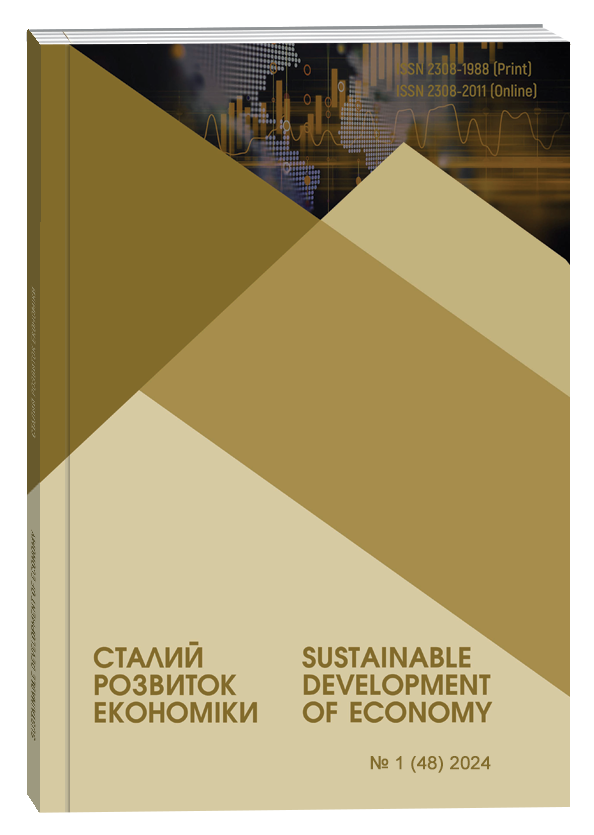SPECIAL ECONOMIC ZONES MECHANISMS AND THEIR ROLE IN THE ECONOMIC DEVELOPMENT OF CENTRAL AND EASTERN EUROPE COUNTRIES (CASE OF POLAND)
Abstract
Special Economic Zones (SEZs) are widely used in most developing countries and in many developed countries. The main goal of this study is to identify mechanisms of SEZs functioning and their role in the economic development of the countries of Central and Eastern Europe (based on the examples of Poland). As a result of the study presented in the article, the conclusions can be drawn that in the countries of Central and Eastern Europe SEZs are successfully used both as a tool of investment and industrial policy, and through the mechanisms of functioning of SEZs, the interests of private investors and national goals of economic development of the countries are actually merged. The formation of SEZs in Central and Eastern European countries is aimed at industrial development, in particular export production, involvement of advanced technologies and domestic R&D, development of innovative potential of the countries, employment generation, etc. SEZs in Poland serves as an effective tool for the investment policy and are actually part of a competitive package of measures that are used to attract foreign investors along with other forms of promotion of foreign investment. In the history of economic development of SEZs, especially in Central and Eastern Europe, a wealth of experience has been accumulated in attracting foreign investment, and its analysis and use can be useful in justifying the methods and organization of state investment policy in transition countries, including Ukraine.
References
Aggarwal A. (2019) SEZs and economic transformatio: towards a developmental approach. Transnational Corporations, no. (26/2), pp. 27–47. Available at: https://unctad.org/system/files/official-document/diaeia2019d2a2_en.pdf
Aviation Valley (2022) SEZs Euro-Park Mielec. Available at: http://www.coi.rzeszow.pl/en/portal-inwestycyjny/podkarpackie-region/special-economic-zones-/sez-europark-mielec/
Borensztein E. J., De Gregorio J., Lee J. W. (2008) How Does Foreign Direct Investment Affect Economic Growth? Journal of International Economics, no. 45 (1), pp. 115–135.
Carkovic M., Levine R. (2002) Does foreign direct investment accelerate economic growth? Peterson Institute for International Economics. Available at: https://www.piie.com/publications/chapters_preview/3810/08iie3810.pdf
Cotula L., Mouan L. (October, 2018) Special economic zones: engines of development or sites of exploitation. Briefing. Available at: https://www.iied.org/sites/default/files/pdfs/migrate/17481IIED.pdf
ESPON (2020) European Special Economic Zones. Available at: https://www.espon.eu/sites/default/files/attachments/Policy%20Brief%20SEZ%20corr%2003-12.pdf
European Commission (2019) Investment Plan: Poland. Available at: https://commission.europa.eu/strategy-and-policy/priorities-2019-2024/economy-works-people/investment-plan-results/investment-plan-poland_en
FDI Intelligence (2023) Free Zones of the Year 2022 – Global winners. Available at: https://www.fdiintelligence.com/content/rankings-and-awards/global-free-zones-of-the-year-2022-81527
Gestrin M. (2019) The contribution of international business investment to the sustainable development goals. OECD. Available at: https://www.oecd.org/investment/The-contribution-of-international-business-investment-to-the-sustainable-development-goals.pdf
Günther J., Kristalova M. (2016) No Risk, No Fun? Foreign Direct Investment in Central and Eastern Europe. Intereconomics, no. (51/2), pp. 90–99.
Humanicki M., Makowski K. (January 30, 2019) The decline in FDI in Poland is the result of structural changes. Obserwator. Available at: https://www.obserwatorfinansowy.pl/in-english/business/the-decline-in-fdi-in-poland-is-the-result-of-structural-changes/
KSSE (2023) Katowice Special Economic Zone. Available at: https://www.invest-ksse.com/ksse-1161
Kuznietsova N. (2023) Special'ni ekonomichni zony ta vplyv inozemnogo kapitalu na ekonomichnyj rozvytok krain, shcho rozvivayut'sya [Special Economical Zones and influence of foreign capital on the economic development of developing countries]. Kyiv: Interservis, 205 p. (in Ukrainian)
Nikoloski K., Miceski T., Paceskoski V. (2015) The Impact Of The Capital On The Economic Development Of The Developing Countries. Annals of the „Constantin Brâncuşi” University of Târgu Jiu, Economy Series, no. (6), pp. 76–81. Available at: https://www.utgjiu.ro/revista/ec/pdf/2015-06/10_Nikoloski,%20Miceski.pdf
Mahembe E., Odhiambo N. (2014) Foreign Direct Investment and Economic Growth: A Theoretical Framework. Jounal of Govtmanct and Regulation, no. (3/2), pp. 63–70. Available at: https://virtusinterpress.org/IMG/pdf/10-22495_jgr_v3_i2_p6.pdf
Pelinescu E., Radulescu M. (2009) The Impact of Foreign Direct Investment on the Economic Growth and Countries’ Export Potential. Journal for Economic Forecasting, no. (4), pp. 153–169. Available at: https://ipe.ro/rjef/rjef4_09/rjef4_09_9.pdf
PITA (2023) Polish Investment & Trade Agency: Doing business in Poland. Available at: https://www.paih.gov.pl/en/wp-content/uploads/sites/2/0/146701/146705.pdf
PITA (2018) The CEE’s Regional Leader: Six Good Reasons For Investors To Choose Poland. Available at: https://www.paih.gov.pl/files/?id_plik=43412
PSEZ (2023) Pomeranian Special Economic Zone: Invest in Pomerania. Available at: https://investinpomerania.pl/en/why-pomeranian/economic-overview/
Prasad E., Rajan R., Subramanian А. (2007) Foreign Capital and Economic Growth. Brooking Paper in Economic Activity, no. (1), pp. 153–230. Available at: https://www.brookings.edu/wp-content/uploads/2007/03/2007a_bpea_prasad.pdf
Rogach О. (2005) Mizhnarodni investicii: teoriya ta praktika biznesu transnacional'nyh korporacij [International investments: theory and practice of business of transnational corporations]. Kyiv: Lybid, 720 p. (in Ukrainian)
UNCTAD (2020) World Investment Report 2019: Special Economic Zones. Available at: https://unctad.org/system/files/official-document/WIR2019_CH4.pdf
UNCTAD (2022) World Investment Report: 2000–2022. Available at: https://unctad.org/publications
U.S. Department of State (2022) Investment Climate Statements - 2020: Poland. Available at: https://www.state.gov/reports/2022-investment-climate-statements/poland/
Warsaw Institute (2020) 25 Years of Special Economic Zones in Poland: A Chance for Investors. Available at: https://warsawinstitute.review/issue-2020/issue-4-2020/25-years-of-special-economic-zones-in-poland-a-chance-for-investors/
World Bank (2022) Data Bank. Available at: https://databank.worldbank.org/home
Yusuf S. (April 6, 2023) It Is to Do Away with Special Economic Zones. Center for Global Development. Available at: https://www.cgdev.org/sites/default/files/time-do-away-special-economic-zones.pdf
Zeng Z. D. (2021) The Past, Present and Future of Special Economic Zones and Their Impact. Jounal of International Economical Law, no. (24/2), pp. 259–280. Available at: https://www.ncbi.nlm.nih.gov/pmc/articles/PMC8083530/pdf/jgab014.pdf


